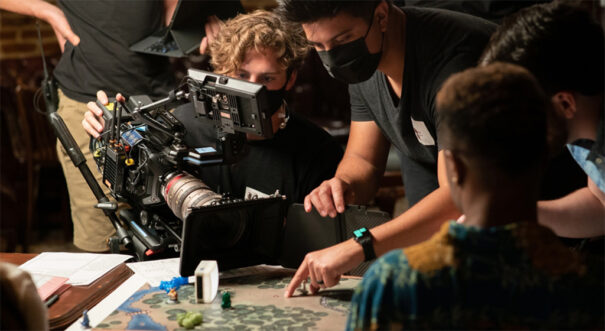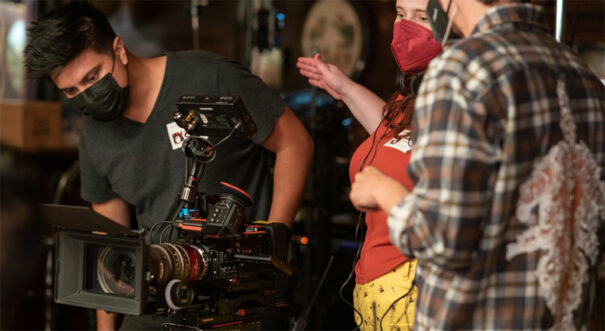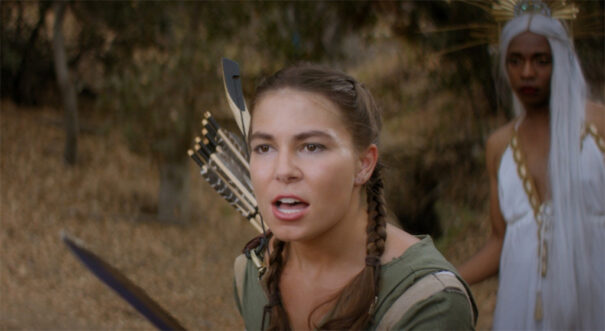First scripted role-playing series comes to life with Blackmagic Design
The Blackmagic URSA Mini Pro 4.6K G2 and DaVinci Resolve Studio software helped bring ‘The Game’, the first scripted series about role-playing games, to life.
The Game tells the story of Brandon, a gamer who has been obsessed with fantasy board games since the age of 15. When his girlfriend cheats on him with his brother and his fragility surfaces, he decides to post a classified ad on Craigslist looking for a group of role-playing fans, only to find five misfits whose stability is questionable. Created by Matt Curtin and Lauren Henningn, and directed by Amanda Sonnenschein, the series takes place in the real world and in a fantasy universe that revolves around gaming.
At the beginning of pre-production, Sonnenschein decided to rely on Merlin Showalter to design the visual aesthetic of the series: “Since the project is this unique hybrid of single camera comedy and fantasy epic, it was really important to me that we cultivated distinct visual styles for each. In order to differentiate our worlds, we decided to shoot our fantasy sequences with anamorphic lenses and a 2.35:1 aspect ratio, while using spherical lenses for the non game portions, which we shot like a single camera comedy show.”
To realise this vision, Showalter knew it would be essential to use a camera that would allow him to switch quickly between spherical and anamorphic lenses. In the end, the Blackmagic URSA Mini Pro 4.6K G2 was chosen for its “versatility and image quality”: “As on most sets, the speed of moving from setup to setup was key, including for the camera crew. The URSA Mini Pro G2 gave us the opportunity to swap lenses and mounts so we could use the optics that we needed on a few moments’ notice, while the intuitive user interface allowed us to quickly make adjustments on the fly.”
Benefits of the URSA Mini Pro 4.6K G2
Sonneschein found the Blackmagic URSA Mini Pro 4.6K G2 to be an extremely useful tool for telling the story as conceptualised, as the opening seconds of the series reveal: “For the opening sequence of our pilot, I wanted to show the characters embroiled in a physical fight across the game table in slow motion. As we track back from the horrified face of Brandon, the Game Master, we see one of the players dramatically knocking the board with all the dice to the floor. The URSA Mini Pro G2’s resolution and frame rate capabilities allowed us to film at 96 frames per second, which gave me the effect I needed to make this sequence as over the top and comedic as possible. The slow motion shots we captured ended up being some of my favorites in the whole project so far!”
Storage of the footage, among other things, was one of the most important considerations for Showalter, which is why he decided to shoot in Blackmagic RAW format: “We wanted the highest quality image possible while keeping our data management and postpipeline in mind. Being able to switch from constant quality to constant bitrate helped us stay on top of days where we were on location with limited ability to turn over cards but have the flexibility of choosing when to get the absolute most out of the camera, like for visual effects shots. We also wanted to be able to get the most flexibility in the color grade and take full advantage of DaVinci Resolve by capturing in Blackmagic RAW.”
The shoot involved many challenging moments, including Showalter’s favourite scene, which involved “complex camera movement”: “Brandon is in a state of shock as his game night unravels into chaos. We staged this fun camera move where we simultaneously dolly backward and zoom out, so as the frame expands from Brandon’s face we reveal the other characters fighting and freaking out in a very dramatic but silly way. Amanda and I were inspired by old Caravaggio paintings, so we shot in a high frame rate with the URSA Mini Pro G2 and lit the scene to feel extra stylized and melodramatic. It took a few takes and quite a bit of rehearsal but we eventually got the shot. Every time I watch that sequence it makes me smile.”
Editing and colour grading with DaVinci Resolve
Sonnenschein was also responsible for editing the pilot. Despite having no previous experience using DaVinci Resolve’s editing tools, he noted how easy the transition to the program was: “This was my first time editing in Resolve, and I found it a very easy transition. The editing interface was very straightforward to work with. ‘The Game’ is first and foremost a comedy, and with comedy in particular, split second precision in cutting is paramount. Resolve made executing those millisecond cuts a pleasant, rather than painstaking, task. The seamless transitions I was able to achieve using Resolve heightened the humorous takes and helped clarify that the real life action is occurring simultaneously with the fantasy world.”
Colour, meanwhile, was the work of Todd Leykamp, who followed a style guide developed with Showalter in pre-production. Colour grading involved distinguishing between the real world and the fantasy universe through changes in colour saturation and light adjustments in specific scenes, such as those filmed in slow motion: “Todd was able to dial up the lighting for those high speed shots to match the rest of the footage in the bar, which made shooting at a high speed and standard frame rate much more usable,” explains Sonnenschein.
Leykamp, looking back on the project, feels that one of the main challenges was the large number of fantasy sequences and visual effects: “I used a different, more ‘poppy’ look, but made sure to retain the same node structure from the bar to keep everything matching and epic. For the VFX shots in the fantasy sequences, I used a fair amount of Power Windows to break up the image and mold the audience’s eye to the castle and dragon specifically. This helped the VFX shots synchronize with the live action fantasy shots.”
The pilot episode of The Game is available on YouTube.
https://youtu.be/-_TdkNHArHk
¿Te gustó este artículo?
Suscríbete a nuestro NEWSLETTER y no te perderás nada.





